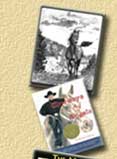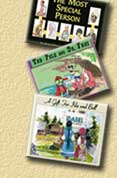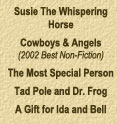
Michael's Monthly Column "Throwing My Loop"
ZEN IN THE ART OF ROPING
The old man sat astride his
pony. The roping had been in progress for hours, and I
wasn’t even aware that I was watching him. As his turn
came, he rode in and with a silky sliding swirl, faced
forward. Even though the horse appeared relaxed – I almost
missed it – the horse was standing straight, but looking
closely I could see the iris of his right eye locked on the
steer. He stared straight ahead, but his crosshairs were
already fixed on the target. He was the arrow of the master
archer at full draw without the slightest quiver, and he had
already taken dead aim. With an imperceptible nod, they
came forth like river water. No longer an old man and an
animal, but a centaur – half man and half horse – a blended
creature with the lower half stretched and hurtling with
ease, and the upper half stretched as well, spinning his
ribbon unfurling in the wind. There was no hurry in any of
it. And I thought…
“Fifty years, I’ve been thinking, learning, riding and
roping for fifty years, and I thought I knew some things.”
But in those two - perhaps three – seconds, I knew I had
never ridden my horse at all.
“I love to watch a horseman at
work,” I said to him after the run.
“I’m no horseman,” he said. “I’ve only been learning about
three years.”
“But you look like you’ve been doing it all your life,” I
said.
“I have,” he said.
And that old fellow and his horse roped the way Hogan struck his ball, the way Clemente played right field, and the way my little Momma cooked. Without effort, with a smooth and silky grace. Without thinking about doing the thing, but doing and being the thing.
In 1953, a man named Eugen Herrigel wrote a small book called Zen In The Art of Archery, and even though it’s less than a hundred pages, he tries at least to capture thoughts and images of how humans might move closer to the thing called mastery.
Herrigel was a German professor who taught philosophy at the University of Tokyo between the wars, and he was deeply interested in learning the ways of the Zen Masters. A Japanese professor suggested he study archery to find what he sought, and the book tells the tale of his journey and his struggle to learn. For six long years, he sat at the knee of an archer who could not only hit the center of the target, but split the first arrow with his second…in the dark. Herrigel’s observations on how we learn, fail, and eventually come to a new place that we never expected to find have affected me for years.
As he begins his lessons with the Master, Herrigel expresses doubts. “Can he really teach me?” he asks himself. “After all, I’m a ‘modern’ man, and this art of archery is based on ancient principles.” And even though his doubts increase, still Herrigel seeks to know and learn how to improve his ability. “No matter how many solutions I looked for,” he said, “I found myself confronted by locked doors…yet could not refrain from constantly rattling the handles.”
In the beginning, things did not go well. At first, Herrigel was unable to even draw the powerful bow for more than a few seconds. Yet his instructor, though not a large man, could hold the bow for very long periods without the slightest strain. At last, Herrigel became convinced the teacher was using some sort of trick that his students could not see. When confronted, the Master thought for a moment, and said, “Ah, yes, I do have trick. I relax and breathe. The reason you can’t do it is that you are not relaxed, and you do not breathe.”
The teacher tried so many times to correct his student that eventually he learned an English word. “Relax,” he would say over and over. “The reason you cannot do it is that you are not relaxed.” Finally he called Herrigel to stand behind him, and feel his arms. Herrigel did as instructed, and while the Master held the bow at full draw, Herrigel searched diligently throughout the teacher’s shoulders, arms and muscles. “Nowhere,” he said, “could I find the slightest tension.”
Herrigel had assumed that after a few weeks he would be an accomplished archer and have developed sufficient skill to awe onlookers. Instead, more than a year passed before he could draw the bow to the satisfaction of his teacher. At long last, the Master pronounced the student ready to continue. “Now,” he said, “we will learn to release the arrow.” Such a task seemed simple enough, but this small act would prove more difficult than anything yet experienced. No matter how hard he tried, Herrigel simply could not do it. His release produced only a jarring thump resulting in a panic-stricken arrow shaken violently off course time after time.
“You must hold the bowstring like
the little child holds his mother’s finger,” the instructor
would say. “We marvel at the strength of the tiny fist, and
when the finger is released, there is not the slightest
jerk. Like the snow falling from the branch. The string is
like the snow. The branch doesn’t release the snow – it
just falls.”
“And when will I learn these things?” the student asked.
“When you are ready,” the teacher would answer. “When it is
time.”
After much effort, and more time
than Herrigel ever imagined, the release of the arrow became
a part of him, and he was overjoyed when the Master agreed
they could begin new exercises involving actually shooting
at targets.
“At least, the worst is over,” Herrigel said.
And his teacher replied, “He who has 100 miles to walk
should remember to count the 90th mile as half
the journey.”
And Herrigel learned more, and more unexpected things than those anticipated. He learned for example that the good archer can shoot farther with a medium bow than the unspiritual archer can with the strongest. He learned that performance depended on presence of mind, and vitality and awareness. And like the dancer who moves without effort, Herrigel learned to spring from his center.
His prowess and skill increased, and as his arrows flew, more and more the cry from the teacher came… “Now! That is the shot!” And at last, the teacher said, “Now do you understand what I mean when I say ‘It shoots,’ ‘It hits’?”
“No, I’m afraid I don’t,” said
Herrigel. “I don’t understand anything more at all. I no
longer know if I shoot the bow, or if it is playing with
me. I don’t know if I hit the goal or it hits me. I can no
longer separate things, and the need to separate is gone.
For as soon as I take the bow and shoot everything becomes
so clear and straightforward and so ridiculously simple…”
“Now at last,” the Master broke in, “the bowstring
has cut right through you.”
And so it is with Old Shine. I think about Herrigel’s little book most every day now when I work with that horse. I think about how in the beginning, like Herrigel, I thought I knew about the thing. I had plans for this horse, and I would just teach him. I never asked him what he thought about it. And then when I felt his fear, I was lost, and stood still not knowing where to turn. Things became different – different inside me – only when I began to forget about my self, and tried to help him. Sometimes he was so afraid, we were reduced to roping phantom cows. He would be so afraid as I loaded imaginary steers in the chute, and when I banged the gate, he would bolt after them. And after roping the ghosts, when I turned him away to head across the pen, he would flee in terror from this thing behind him…and there was nothing there. So many times, and after enough times, when it was time – when he was ready – he became more. In the beginning, I thought he was the student, but now I know he was my teacher. At last…like the bowstring cut through the archer, Old Shine cut right through me.
“I love to watch a horseman at
work,” I said after his run.
“I’m not a horseman,” the old man said. “I’ve only been
learning for three years.”
“Coulda’ fooled me,” I replied. “ You look like you’ve been
doing it all your life.”
“Oh, I have,” he said. “I have.”
SHINE THE WONDER HORSE, and his faithful companion, Michael Johnson
Michael's latest release, Reflections Of A Cowboy, is currently available in audio book form. The two volume set consists of articles, essays and excerpts from radio performances about good people and good horses in the life of an Oklahoma cowboy. Approximately 8 hours in length. Reflections Of A Cowboy in printed form is scheduled for release in the summer of 2005. Order from Michael's website.
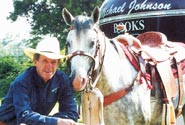 |
|||||
|
|
|||||
|
|||||
|
|
|||||
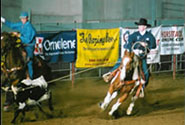 |
|||||
|
Michael heading for the great Sonny Gould |
|||||
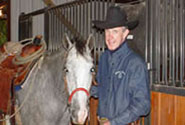 |
|||||
|
Michael & Blue |
 |
|
Please stop |
|
|
|
Send Michael |
Michael Johnson Books
michaelspeaks@msn.com
1172 CR 4122 Campbell, Texas 75422 (903) 862-2082

webmaster
pswope@candw-webmasters.com

